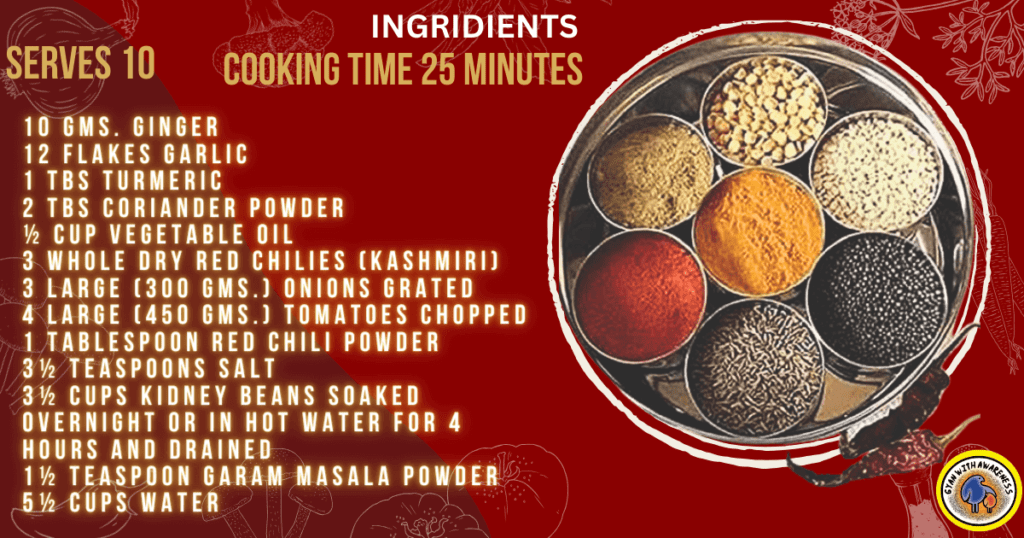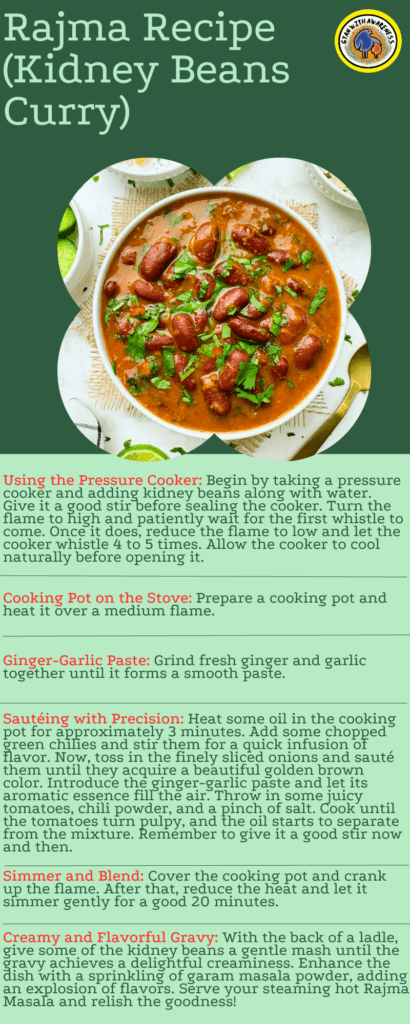Rajma Masala Gravy is commonly known as Kidney Beans Curry, The Rajma recipe is a popular and cherished dish in Indian cuisine. The most famous preparation of Rajma is “rajma chawal”. To create Rajma Masala, the rajma seeds are soaked and cooked with an assortment of aromatic spices, creating a flavorsome and hearty curry. This delicious rajma seed (legume) has a rich history that traces back to its origin in South America.
Rajma Masala, a beloved North Indian delicacy, is more than just a tasty meal; it’s a nutritional powerhouse. These kidney-shaped beans are simmered in a fragrant tomato-based gravy, creating a symphony of flavors. Rich in plant-based protein and fiber, Rajma Masala is not only satisfying but also promotes a feeling of fullness, aiding in weight management. Its combination of vitamins, minerals, and antioxidants supports overall health, boosting immunity and promoting heart health. With every hearty spoonful, you savor tradition and nourishment, making Rajma Masala a delightful and wholesome addition to your plate.
About Rajma Masala
In the southern Indian state of Andhra Pradesh, Rajma is referred to as “Chikkudu Kaya” in the Telugu language. While the name differs, the love for this legume remains consistent across the country.
The dish is a perfect blend of nutrition and taste, rich in protein, fiber, and essential minerals.
Whether relished at a family dinner or served at festive gatherings, Rajma continues to be an all-time favorite, cherished for its cultural significance and delectable taste. Its versatility and wholesome goodness have made Rajma a cherished culinary gem that has found its way into the hearts and plates of Indians nationwide.
Rajma Masala Recipe And Health:
Rajma Masala Recipe is full of lovely taste and health benefits. Here are some reasons why people love to eat it for a healthy body.
Rich in protein: Rajma masala is a large source of plant-based protein, which is necessary for the growth and repair of muscles.
Fiber Powerhouse: It contains a lot of dietary fiber, which helps with digestion, encourages fullness and controls blood sugar levels.
Low in Fat: Rajma, when prepared without excessive oil or ghee, is a heart-healthy alternative because it is naturally low in fat.
Rich in vital elements like potassium, magnesium, folate, and iron, foods that are nutrient-dense are beneficial to general health.
Rajma has antioxidant properties, including anthocyanins, which fight oxidative stress and lower the chance of developing chronic diseases.
Blood Sugar Control: For people with diabetes, the combination of fiber and complex carbs helps to normalize blood sugar levels.
Weight Management: The fiber and protein in this food help you feel full, which helps you manage your weight by consuming fewer calories overall.
Rajma’s soluble fiber is thought to be responsible for its association with lower cholesterol levels, which is good for the heart.
Calcium, magnesium, and phosphorus are provided to maintain strong and healthy bones.
Gut health: By reducing constipation and encouraging regular bowel movements, the fiber in rajma helps to maintain a healthy digestive tract.
Rajma Masala can be a flavorful and healthy addition to your diet, providing a wealth of health advantages in addition to its delectable taste.
Read More: 5-Mins Healthy Matar Paneer Recipe: Quick, Easy and Delicious!
Dal Makhni Recipe and 10 Amazing Health Benefits
Chana Masala: A Flavorful Delight Packed with 8 Health Benefits
NORTH INDIAN RECIPES
Rajma Masala Recipe (Kidney Beans Curry)
course: Main Course Diet: Vegetarian
Prepare Time: 10 mins Pressure Cooking Time: 25 mins
Total Time: 35 mins Serves: 10
Nutrition:
Calories 235 Total Fat 3.4g
Saturated Fat 0.6g Trans Fat 0g
Polyunsaturated Fat 0.7g Monounsaturated Fat 1.8g
Cholesterol 1.5mg Sodium 354mg
Total Carbohydrates 43g Dietary Fiber 6.5g
Sugars 2.6g Protein 9.5g
Vitamin D 0mcg Calcium 57mg
Iron 2.4mg Potassium 504.8mg
Ingredients:
10 gms. Ginger
12 flakes garlic
1 Tbs TURMERIC
2 Tbs coriander powder
½ cup vegetable oil
3 whole dry red chilies (Kashmiri)
3 large (300 gms.) onions grated
4 large (450 gms.) tomatoes chopped
1 tablespoon red chili powder
3½ teaspoons salt
3½ cups kidney beans soaked overnight or in hot water for 4 hours and drained
1½ teaspoon garam masala powder
5½ Cups water
Making a sizzling dish step by step!!
Using the Pressure Cooker: Begin by taking a pressure cooker and adding kidney beans along with water. Give it a good stir before sealing the cooker. Turn the flame to high and patiently wait for the first whistle to come. Once it does, reduce the flame to low and let the cooker whistle 4 to 5 times. Allow the cooker to cool naturally before opening it.
Cooking Pot on the Stove: Prepare a cooking pot and heat it over a medium flame.
Ginger-Garlic Paste: Grind fresh ginger and garlic together until it forms a smooth paste.
Sautéing with Precision: Heat some oil in the cooking pot for approximately 3 minutes. Add some chopped green chilies and stir them for a quick infusion of flavor. Now, toss in the finely sliced onions and sauté them until they acquire a beautiful golden brown color. Introduce the ginger-garlic paste and let its aromatic essence fill the air. Throw in some juicy tomatoes, chili powder, and a pinch of salt. Cook until the tomatoes turn pulpy, and the oil starts to separate from the mixture. Remember to give it a good stir now and then.
Simmer and Blend: Cover the cooking pot and crank up the flame. After that, reduce the heat and let it simmer gently for a good 20 minutes.
Creamy and Flavorful Gravy: With the back of a ladle, give some of the kidney beans a gentle mash until the gravy achieves a delightful creaminess. Enhance the dish with a sprinkling of garam masala powder, adding an explosion of flavors. Serve your steaming hot Rajma Masala and relish the goodness!
Tips By Mee to make it more Yumm!!!!!!!!!
Soak Rajma Thoroughly: Soak the kidney beans (rajma) overnight or for at least 6-8 hours. This ensures they cook evenly and have a better texture.
Use Fresh Ingredients: Choose fresh tomatoes, onions, and spices to maximize flavor.
Roast Spices: Dry roast your whole spices like cumin seeds, coriander seeds, and cardamom pods before grinding them for a richer flavor.
Onion-Tomato Base: Sauté onions and tomatoes until they are well-cooked and slightly caramelized. This forms the flavorful base of the gravy.
Balanced Spice Mix: Pay attention to the proportion of spices. Balance is key; adjust chili powder, cumin, and coriander to suit your taste.
Garlic and Ginger Paste: Use freshly crushed ginger and garlic for a more robust flavor compared to store-bought pastes.
Slow Cooking: Permit the rajma to cook for a protracted amount of time on low heat. This enables the tastes to combine and mature completely.
Finish with Ghee: Ghee (clarified butter) can give a dish a rich, aromatic touch when added at the very end.
Fresh Coriander: To add a blast of freshness, garnish with freshly chopped coriander leaves.
Lemon Juice: Just before serving, add a squeeze of fresh lemon juice to accentuate the taste.
Salt: Don’t forget to season to taste; it will have a big impact on the final flavor.
In conclusion, Rajma Masala is a quintessential Indian dish renowned for its delightful taste and numerous health benefits. Its rich, aromatic gravy, infused with a blend of spices, imparts a savory and satisfying flavor that pleases the palate of food enthusiasts worldwide. Beyond its delectable taste, Rajma Masala offers several health advantages. Packed with plant-based protein, fiber, and essential nutrients, it supports muscle growth, aids digestion, and helps regulate blood sugar levels. Additionally, the antioxidants and anti-inflammatory properties of the spices used in this dish contribute to overall well-being. Rajma Masala thus stands as a testament to the harmonious fusion of flavor and nutrition in Indian cuisine.
FAQ:
What is rajma masala made of?
Red kidney beans, or Rajma, are the main ingredient in the renowned North Indian meal Rajma masala, which is cooked in a tasty tomato-based gravy. It is a popular vegetarian meal in Indian cooking and is high in protein. Red kidney beans are soaked, boiled, and then simmered in a tomato-onion stew that is spiced, usually with ginger, garlic, cumin, coriander, garam masala, and chili powder. Fresh coriander leaves are used to garnish the dish, which is eaten with rice or roti, an Indian flatbread. It is a popular comfort food in India because of its substantial, soothing flavor.
What is the Indian name for Rajma?
In India, Rajma is known by its Hindi name, “राजमा” (pronounced as “raaj-maa”).
Is rajma good for health?
Red kidney beans, often known as rajma, can be an advantageous part of a balanced diet. As a result of their high nutritional profile, they provide numerous health benefits. Rajma is a superior plant-based source of protein, making it very useful for vegetarians and vegans who need to fulfill their protein needs. By encouraging a sense of fullness, its high fiber content improves weight management by regulating blood sugar levels and supporting digestive health.
Rajma’s low saturated fat content enhances heart health and minimizes the risk of cardiovascular disease. It is high in vitamins and minerals such as iron, potassium, folate, and magnesium, which are essential for several bodily activities. Rajma includes antioxidants, which may help fight hazardous free radicals and lower your chance of acquiring chronic diseases.
Is Rajma heavy food?
Rajma, a popular North Indian dish, can be considered relatively heavy due to its rich, protein-packed nature. It primarily consists of red kidney beans cooked in a thick tomato-based gravy with various spices. While it provides essential nutrients, including protein and fiber, its high calorie and carbohydrate content may make it feel heavy on the stomach. Additionally, the presence of oil and spices can contribute to its perceived heaviness. It’s a satisfying and nutritious meal, but individuals with sensitive digestive systems may find it a bit heavy, especially if consumed in large quantities.
Can rajma cause gas?
Rajma, or red kidney beans, can cause gas and intestinal discomfort in some people. This is because they contain complex carbohydrates that are not completely broken down in the small intestine. Instead, they pass through the small intestine and are digested by gut bacteria, creating gas as a byproduct. To help lower oligosaccharide content, soak dried rajma before cooking and thoroughly rinse canned beans before cooking. Furthermore, gradually adopting them into your diet and incorporating digestive aids such as cumin or fennel seeds may reduce potential digestive troubles connected with rajma consumption.
Is Rajma Masala good for weight loss?
Yes, rajma masala, or red kidney beans, can be beneficial for weight loss. They are a good source of plant-based protein and fiber, both of which promote a feeling of fullness and can help control appetite. The complex carbohydrates in rajma provide sustained energy, reducing the likelihood of overeating. Furthermore, the fiber content aids in regulating blood sugar levels and improving digestion. Additionally, rajma is low in fat and contains various vitamins and minerals. However, portion control is essential as they are moderately calorific. When incorporated into a balanced diet and coupled with regular exercise, rajma can be a valuable component of a weight loss regimen.


